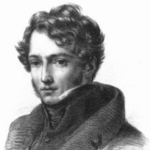Background
Émile Jean-Horace Vernet was born on June 30, 1789 to Carle Vernet, another famous painter, who was himself a son of Claude Joseph Vernet. He was born in the Paris Louvre, while his parents were staying there during the French Revolution.

lithographer painter draughtsman
Émile Jean-Horace Vernet was born on June 30, 1789 to Carle Vernet, another famous painter, who was himself a son of Claude Joseph Vernet. He was born in the Paris Louvre, while his parents were staying there during the French Revolution.
Horace was casually trained by his father.
A prodigy in his childhood, a professional in his teens, he was spurred by financial needs arising from his early marriage in 1811 to exploit his phenomenal native facility. A torrent of saleable work soon poured from his studio: fashion designs, caricatures, portraits, horses in the manner of Carle, and landscapes in the manner of Joseph.
In 1814 he was among the civilian defenders of Paris against the approaching allies, an episode he later represented in La Barrière de Clichy (1820, Louvre).
In the early years of the Restoration, his studio became the meeting place of artists and veterans openly hostile to the Bourbon government. Much to that government's irritation, he flaunted his cult of Napoleon and found a patron in Louis-Philippe, duc d'Orléans, head of the disaffected cadet branch of the dynasty. A resolute modernist but little affected by romanticism, he befriended Gericault and was one of the Pioneers of lithography. In a series of battle scenes from the Revolutionary and Napoleonic Wars, Jemmapes, Montmirail, Hanau, and Valmy, painted for the duc d'Orléans in 1821-1826 (National Gallery, London), he gave a foretaste of what was to become his speciality. His discreetly conciliatory gestures to the government had meanwhile been gratefully received and were producing prompt results.
In short order, he was made an officier of the Legion of Honor (1825), a member of the Institute (1826), and after successes at the Salons of 1826 and 1827 was appointed director of the French Academy in Rome (1829).
During his seven years there, he displayed an agile versatility with paintings of Italian popular life (Tbe Brigand's Confession), oriental subjects (Tbe Arab Story-teller), and historical anecdotes (Encounter of Raphael and Michelangelo in the Vatican).
The Revolution in July 1830, which raised Louis-Philippe, Vernet's patron, to the throne, opened vast opportunities of official employment to him. The rapid flow of state commissions for battle pieces that now came his way taxed even his prodigious facility. Four very large canvases for the Galerie des Batailles at Versailles, shown at the Salon of 1836, were followed by a second series in 1841.
Accepting his calling as that of a painter of modern national subjects, specifically of scenes of combat, Vernet conceived of his work as a form of eyewitness reportage that required observation at the actual theaters of war.
In five long visits to North Africa (1833, 1837, 1839-1840, 1845, 1853), he gathered on-the-spot documentation of the French conquests in Algiers and Morocco, material that he later worked up into wall-size canvases destined for Versailles. Louis-Philippe's overthrow by the Revolution of 1848 and the advent of Napoleon III in 1849 scarcely affected his activity. The year 1850 found him at the French siege of Rome; in 1854 he visited the battlefields of the Crimea. He had in the meantime enjoyed the lucrative patronage of Czar Nicholas I during two long visits to Russia in 1836 and 1842-1843.
The Universal Exposition of 1855, at which he was represented by twenty-four paintings, crowned his popular and official success. His reputation among artists and critics, on the other hand, was not uncontested.
Baudelaire scathingly referred to him as "un militaire qui fait de la peinture," and while his painstaking factuality and the sheer magnitude of his production commanded respect, the prosy shallowness of his realism, his stylistic banality, and the stridency of his chauvinism were early noted and contributed to the eventual neglect of his work.
He died in 1863.
Angel of Death
1851Arab Chieftains in Council (The Negotiator)
1834A Saddled Race Horse Tied to a Fence
1828Departure for the Hunt in the Pontine Marshes
1833Hunting in the Pontine Marshes
1833Juda et Thamar
1840Napoleon Bonaparte leading his troops over the bridge of Arcol
1826Portrait of an Arab
Scene from the Mexican Expedition in 1838
1841Street Fighting on Rue Soufflot, Paris, June 25, 1848
The Arab Tale-Teller
1833The Battle of Habra, Algeria, December 1835
1840The Battle of Hanau
1824The Battle of Montmirail
1822The Battle of Valmy (September 20th 1792)
1835The Emperor Napoleon I
1815The Lion Hunt
1836The Lion Hunter
1833Village Musicians
1832Horace was married in 1811.

